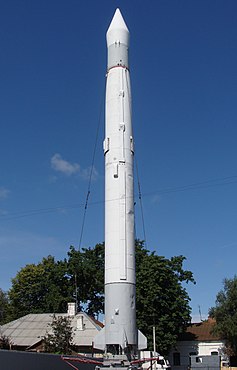R-5 (missile)
| R-5 (missile) | |
|---|---|
|
|
|
| General Information | |
| Type | Medium-range missile |
| Local name | R-5, 8K51, 8A67 |
| NATO designation | SS-3 Shyster |
| Country of origin |
|
| Manufacturer | KB Korolyov |
| development | 1953 |
| Commissioning | 1956 |
| Working time | 1956-1967 |
| Technical specifications | |
| length | 20.80 m |
| diameter | 1,650 mm |
| Combat weight | 28,610 kg |
| span | 3,452 mm |
First stage drive |
RD-103 liquid rocket engine |
| Range | 1,200 km |
| Furnishing | |
| steering | INS plus radio command steering |
| Warhead | 1 nuclear warhead 30 or 80 kt or 1,500 kg fragmentation warhead |
| Weapon platforms | Mobile on a semi-trailer , start from the starting table |
| Lists on the subject | |
The R-5 ( NATO code name SS-3 Shyster , GRAU index 8K51 ) was a medium-range missile with liquid fuel propulsion of the USSR . Their development originally aimed at a strategic missile with a range of 3,000 km, which would theoretically have been possible, but was inefficient in practice. A reduced range of 1,200 km was accepted and flight tests began in 1953. Originally, the R-5 was only designed for a range of 800 km, which was later increased by changing the fuel mixture used. In contrast to the predecessor models R-1 and R-2 , which were still based on the German A4 , the rocket had tanks made of aluminum and magnesium alloys and was made in a monocoque design, which enabled great weight savings to be achieved. The RD-103 rocket engine was developed by Valentin Gluschko in the OKB-456 and was based on a further development of the A4 engine with almost doubled thrust using fuel with 92% alcohol content (A4 with 75%). Compared to the previous models mentioned, the cooling has been sustainably improved and flexible fuel supply lines have been used. In the first few years only the first version of the R-5 was produced, the nuclear variant R-5M with an atomic warhead only went into production in 1956 after further tests.
Due to its subsequently increased range, the R-5 was the first strategically really usable rocket, as it could reach targets in Central Europe . A hit accuracy ( CEP ) of 1,200 to 2,000 meters was achieved (depending on the shooting distance). A single R-5 took about 2.5 to 5 hours to prepare for takeoff and, due to the frozen liquid oxygen, could not stay on the launch pad for more than a day. Thus the R-5 could not be kept in constant readiness for action.
The R-5M was stationed from May 1956 and retired in 1967. In the Moscow military parade on November 7, 1957 on the 40th anniversary of the October Revolution, it was presented to the world public for the first time as a real nuclear threat. R-5M equipped with a nuclear warhead were stationed for the first time outside the USSR in the GDR in Vogelsang and Fürstenberg / Havel during the Berlin crisis in May 1959 . Their possible targets were air force bases and ports in West Germany , the Netherlands , Belgium and US missile sites in Great Britain . After secret negotiations with the United States and some concessions, the missiles were withdrawn in August 1959.
The People's Republic of China was awarded thanks to Soviet military aid to 1959, the R-5 and was able to be fitted with a nuclear warhead with the rise of a nuclear power 1964th
The missile served as the basis for the later R-12 with an extended range and heavier warhead.
An R-5 is on display in front of the Cosmonautics Museum in honor of Sergei Pavlovich Korolev in Zhytomyr , Ukraine.
See also
Web links
- R-5 in the Encyclopedia Astronautica (English)
- http://www.russianspaceweb.com/r5.html (English)
Individual evidence
- ^ A b c Matthias Uhl : Stalin's V-2. The technology transfer of German radio controlled weapons technology to the USSR and the development of the Soviet missile industry from 1945 to 1959 . Dissertation with reproduction of many original documents. Bernard & Graefe Verlag, Bonn 2001, ISBN 978-3-7637-6214-9 (304 pages).


